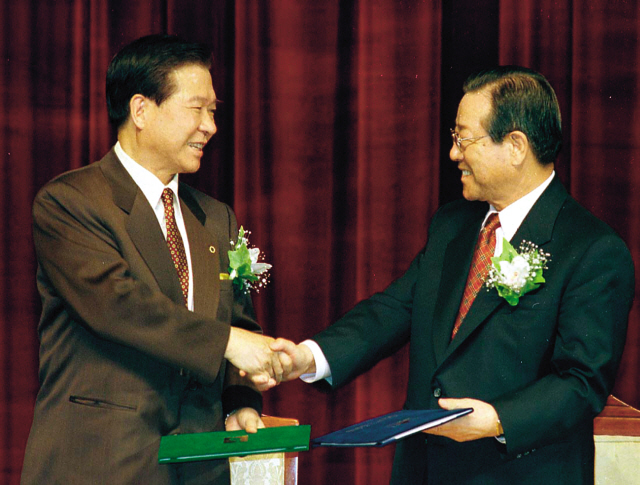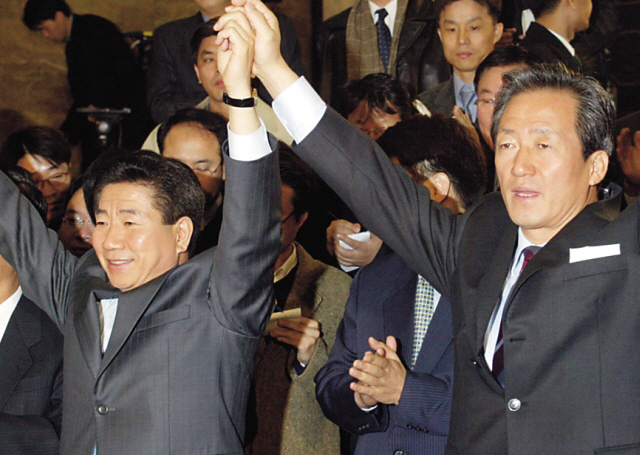Past candidate mergers leave lessons for Moon, Ahn
History shows electoral alliance wins votes but, without shared political vision, ends up in failure
By Korea HeraldPublished : Nov. 12, 2012 - 21:02
Since Korea ended the military-backed dictatorship and restored a direct presidential vote in 1987, a candidacy merger ― or the lack thereof ― has been the biggest electoral game changer.
A failure of alliance between two pro-democracy leaders, Kim Young-sam and Kim Dae-jung, that year split the liberal vote and resulted in rule by general-turned-politicians being extended.
The two magnates separately joined forces with conservatives and gained power in 1992 and 1997, respectively. In 2002, another joint candidacy between politicians with different ideological leanings and its abrupt collapse on the eve of the polling day ended up in one partner’s dramatic win.
Voters are keen to see whether history will repeat this year as the two liberal candidates, Moon Jae-in and Ahn Cheol-soo, begin talks to merge their campaigns to compete against seasoned conservative Park Geun-hye.
The candidates are taking lessons from the past. They give a priority to presenting their common political vision to reassure the voters who witnessed electoral alliances without shared values crumble after bitter feuds.
Kim DJ-Kim JP coalition
“The mergers between candidates allowed significant electoral gains,“ said Kim Yong-ho, professor of political science at Inha University. “But the coalition tickets were formed not on the basis of shared ideology or values, but on the basis of regional support.”
A noticeable trend in Korean elections has been the tripartite voting bloc forged across regional boundaries on the basis of the “Three Kims” ― Kim Jong-pil, Kim Dae-jung and Kim Yong-sam ― who respectively garnered strong local support from the Chungcheong, Jeolla and Gyeongsang regions.
In the 1996 congressional elections, Kim Dae-jung’s newly formed party of National Congress for New Politics gained only 79 seats among the available 299 in the National Assembly. The defeat raised a red flag for Kim, who had returned from studying at Cambridge University in England after losing his third bid for the presidency in 1992.
A failure of alliance between two pro-democracy leaders, Kim Young-sam and Kim Dae-jung, that year split the liberal vote and resulted in rule by general-turned-politicians being extended.
The two magnates separately joined forces with conservatives and gained power in 1992 and 1997, respectively. In 2002, another joint candidacy between politicians with different ideological leanings and its abrupt collapse on the eve of the polling day ended up in one partner’s dramatic win.
Voters are keen to see whether history will repeat this year as the two liberal candidates, Moon Jae-in and Ahn Cheol-soo, begin talks to merge their campaigns to compete against seasoned conservative Park Geun-hye.
The candidates are taking lessons from the past. They give a priority to presenting their common political vision to reassure the voters who witnessed electoral alliances without shared values crumble after bitter feuds.
Kim DJ-Kim JP coalition
“The mergers between candidates allowed significant electoral gains,“ said Kim Yong-ho, professor of political science at Inha University. “But the coalition tickets were formed not on the basis of shared ideology or values, but on the basis of regional support.”
A noticeable trend in Korean elections has been the tripartite voting bloc forged across regional boundaries on the basis of the “Three Kims” ― Kim Jong-pil, Kim Dae-jung and Kim Yong-sam ― who respectively garnered strong local support from the Chungcheong, Jeolla and Gyeongsang regions.
In the 1996 congressional elections, Kim Dae-jung’s newly formed party of National Congress for New Politics gained only 79 seats among the available 299 in the National Assembly. The defeat raised a red flag for Kim, who had returned from studying at Cambridge University in England after losing his third bid for the presidency in 1992.

With the electorate divided on the basis of regional boundaries, Kim garnered overwhelming votes from the Jeolla regions but paltry support from the Gyeongsang regions, which has been a stronghold for conservative candidates since President Park Chung-hee’s rule.
The problem for the liberal Kim was that the number of eligible voters in the Jeolla region at the time was 3.4 million, while that of the Gyeongsang region was 8.2 million. The headcount simply did not match up.
The future Nobel Laureate’s strategy for the 1994 presidential election was to form a coalition ticket with Kim Jong-pil, the former right-hand man of President Park Chung-hee, who headed a conservative party with strong local support in the Chungcheong region.
The DJP coalition allowed “the reactionary forces to concentrate support in the Chungcheong region,” wrote Park Gwang-kee, a politics professor at Daejon University.
The two Kims agreed to form a coalition on the promise of a power-share agreement based on constitutional reforms to allow for a parliamentary form of government, which would relegate the appointment of key cabinet posts to the National Assembly, with the prime minister taking on the administrative duties previously concentrated in the presidency. Kim Jong-pil was promised the post of prime minister while Kim Dae-jung became the coalition’s single candidate.
Park Tae-joon, the former head of POSCO who had a strong political support base in South Gyeongsang Province, also joined the coalition, allowing Kim to make significant electoral gains in the Gyeongsang region.
“The DJP coalition was a merger of hegemonic political powers,” said Han Sang-heui, a constitutional law professor at Konkuk University.
“Each [candidate] came to the negotiating table with an interest to protest his vested interests. As a result, it was a coalition ridden with anxiety.”
The coalition nevertheless proved highly successful. Kim Dae-jung collected 14 percent of the votes in the TK bloc comprised of Daegu and North Gyeongsang Province, and 315,000 more votes in the Chungcheong region compared to the 1992 election. Kim narrowly defeated the conservative Grand National Party’s Lee Hoi-chang by just over 390,000 votes.
But once in power, the DJP coalition often invited turbulent conflict. “The DJP coalition was not really a coalition in the sense that each [candidate] still maintained his vested interests and ideological frame once in power,” said Han. “Their coalition was more a merger of two hegemonic powers, each with its own power group. It was a strategic grouping.”
The two especially ran into conflict regarding North Korea, as Kim Dae-jung pushed his Sunshine Policy of dialogue and cooperation with the North, while Kim Jong-pil, the former head of Korean Central Intelligence Agency, maintained a hardline stance.
“The disparate DJP coalition group constantly fought over North Korea and other important policy decisions,” wrote Kim Hyung-jun, a politics professor at Myongji University.
“So in order for a political experiment called a power-sharing government, which comes with high levels of uncertainty and unpredictably, to succeed, there must be institutional mechanisms to maintain stability, such as agreements on term of the prime minister, and how cabinet posts are to be divided up.”
Roh-Chung alliance
Starting from the 2004 congressional elections, with the exit of the “Three Kims” from the political stage, the electoral base that was forged on regional boundaries gradually faded, although the division base between the Gyeongsang and Jeolla regions still stood. Conflicts between different age groups and ideological leanings entered the debate.
The drama behind the coalition ticket between Roh Moo-hyun and Chung Mong-joon, which fell apart the night before people were to take to the voting booth, began to unfold six weeks before the 2002 presidential election.

Roh, the son of a poor farmer, had studied his way out of poverty. He graduated from a vocational high school and without money to attend college, worked in construction as a common laborer. He built a small cabin near his home and studied for the bar exam.
After a brief stint as a judge, Roh went on to become a successful tax lawyer. He became a human rights lawyer after taking up several pro bono cases defending labor workers and student activists who were interrogated and tortured during the authoritarian rule of Chun Doo-hwan.
Chung Mong-joon, on the other hand, was born into the Hyundai chaebol family. He studied economics at Seoul National University and earned a Ph.D. in international politics at Johns Hopkins University. One of the richest businessmen and politicians in the nation, Chung held the post of vice president of FIFA, and also a seat in the National Assembly representing the industrial city of Ulsan, where Hyundai Heavy Industries was concentrated.
Shortly before talks of forging a coalition ticket started, Chung led Roh in the opinion surveys. A poll by the Joongang Ilbo in late October had found that Lee Hoi-chang led the pack with a 37.2 percent lead, followed by Chung with 26.6 percent and Roh with 18.4 percent.
But after the two agreed to form a coalition ticket on the basis of opinion surveys, Roh’s popularity went up, and eventually Roh was chosen as the single candidate of the coalition.
“It is difficult to call the Roh-Chung merger a coalition, as similar to the DJP coalition, it was merely a strategic move to win the election, not a coming together of political philosophy or values,” said Han. “On the surface, each seemed to cover each other’s weaknesses.”
Roh enjoyed popularity among young voters in their 20s and 30s, and also as the candidate of the Democratic Party, had an organized political support base and accumulated human capital over the years, while Chung had formed his own party and lacked this level of political organization. But Chung had extensive experience in business and also leading an international organization.
But the coalition fell apart the day before the election, as Chung cited their differing stance on North Korea as a reason. Roh went on to defeat Lee in the election, by 2.3 percent.
By Samuel Songhoon Lee (songhoon@heraldcorp.com)
-
Articles by Korea Herald









![[KH Explains] Naver’s Line dilemma: Lose global footing for cash?](http://res.heraldm.com/phpwas/restmb_idxmake.php?idx=644&simg=/content/image/2024/05/14/20240514050624_0.jpg&u=)
![[Herald Interview] Carbon breakthrough in Korea: Making diamonds at atmospheric pressure](http://res.heraldm.com/phpwas/restmb_idxmake.php?idx=644&simg=/content/image/2024/05/14/20240514050559_0.jpg&u=20240514184059)








